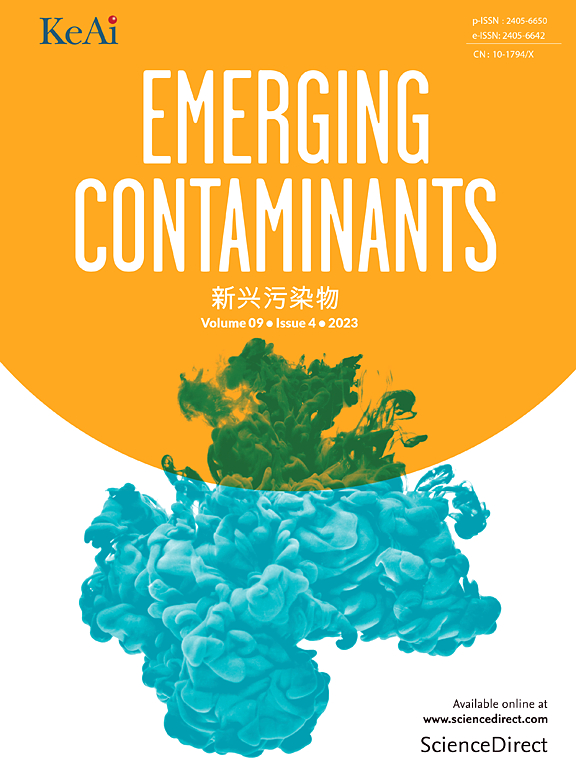Transcriptomic and metabolomic analysis reveals hepatic lipid metabolism disruption in Japanese quail under polystyrene microplastics exposure
IF 6.9
2区 环境科学与生态学
Q1 ENVIRONMENTAL SCIENCES
引用次数: 0
Abstract
Microplastics (MPs) become a global concern due to their impacts on human and wildlife health. In this study, we attempted to determine the hepatotoxic effects of MPs exposure on birds by using a laboratory model animal-Japanese quail (Coturnix japonica) through integrating transcriptomic and metabolomic analysis. Seven-day old female chicks were exposed to low concentrations (0.02 mg/kg, 0.4 mg/kg) and high concentration (8 mg/kg) polystyrene microplastics (PS-MPs) of environmental relevance in the feed for 35 days. The results showed that 0.02 mg/kg and 0.4 mg/kg PS-MPs exposure caused increasing food and water intake with weight gain and liver lipid droplets accumulation while 8 mg/kg PS-MPs exposure induced decreasing food and water intake with weight loss. Moreover, both microstructural damage and ultrastructural injury indicated liver malfunction by PS-MPs exposure. PS-MPs also led to hepatic oxidative stress. Furthermore, untargeted metabolomic analysis showed lipid metabolism disturbance in the liver of PS-MPs exposure. Transcriptomic results also showed molecular signaling pathway disruption in the liver of PS-MPs exposure. Especially, lipid metabolism including peroxisome proliferator activated receptor (PPAR) signaling pathway, fatty acid oxidation, primary bile acid synthesis and triglyceride metabolism were disrupted by PS-MPs exposure. The present study concluded MPs exposure might have hormetic effects on bird development and it posed risks to bird health with low dose MPs may induce non-alcoholic fatty liver disease while high dose MPs may cause severe histopathological injury and oxidative damage. This study underscored the importance of evaluating the chronic effects of microplastics on birds.

转录组学和代谢组学分析揭示了聚苯乙烯微塑料暴露下日本鹌鹑肝脏脂质代谢的破坏
微塑料(MPs)由于对人类和野生动物健康的影响而成为全球关注的问题。在这项研究中,我们试图通过整合转录组学和代谢组学分析,利用实验室模型动物-日本鹌鹑(Coturnix japonica)来确定MPs暴露对鸟类的肝毒性作用。将7日龄雌雏鸡分别暴露于低浓度(0.02 mg/kg、0.4 mg/kg)和高浓度(8 mg/kg)的环境相关聚苯乙烯微塑料(PS-MPs)饲料中35 d。结果表明,0.02 mg/kg和0.4 mg/kg的PS-MPs暴露导致小鼠摄食量和饮水量随着体重增加和肝脂滴积累而增加,而8 mg/kg的PS-MPs暴露导致小鼠摄食量和饮水量随着体重减轻而减少。此外,PS-MPs暴露引起的微结构损伤和超微结构损伤均提示肝脏功能障碍。PS-MPs还会导致肝脏氧化应激。此外,非靶向代谢组学分析显示,暴露于PS-MPs的肝脏脂质代谢紊乱。转录组学结果还显示,暴露于PS-MPs的肝脏中的分子信号通路受到破坏。特别是脂质代谢,包括过氧化物酶体增殖物激活受体(PPAR)信号通路,脂肪酸氧化,初级胆汁酸合成和甘油三酯代谢被PS-MPs暴露破坏。本研究认为,MPs暴露可能对鸟类发育产生致效作用,并对鸟类健康构成风险,低剂量MPs可诱发非酒精性脂肪性肝病,高剂量MPs可引起严重的组织病理学损伤和氧化损伤。这项研究强调了评估微塑料对鸟类的慢性影响的重要性。
本文章由计算机程序翻译,如有差异,请以英文原文为准。
求助全文
约1分钟内获得全文
求助全文
来源期刊

Emerging Contaminants
Medicine-Public Health, Environmental and Occupational Health
CiteScore
10.00
自引率
6.70%
发文量
35
审稿时长
44 days
期刊介绍:
Emerging Contaminants is an outlet for world-leading research addressing problems associated with environmental contamination caused by emerging contaminants and their solutions. Emerging contaminants are defined as chemicals that are not currently (or have been only recently) regulated and about which there exist concerns regarding their impact on human or ecological health. Examples of emerging contaminants include disinfection by-products, pharmaceutical and personal care products, persistent organic chemicals, and mercury etc. as well as their degradation products. We encourage papers addressing science that facilitates greater understanding of the nature, extent, and impacts of the presence of emerging contaminants in the environment; technology that exploits original principles to reduce and control their environmental presence; as well as the development, implementation and efficacy of national and international policies to protect human health and the environment from emerging contaminants.
 求助内容:
求助内容: 应助结果提醒方式:
应助结果提醒方式:


